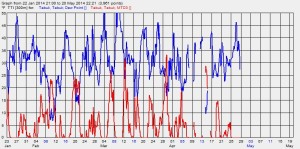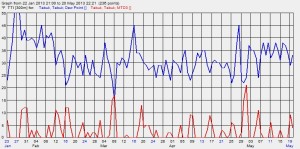Tabuk 2014: Tabuk 2013:
In Tabuk, in the Kingdom of Saudi Arabia the humidity levels exhibit variation from one day to the next. The red lines on the graphs above show the daily variation in humidity which has been especially bad this year. Tabuk was selected for this analysis because of their recent outbreak of MERS and its physical location away from the coast.
The red line is a special function developed to take 72 hours of the derivative of AH(Absolute Humidity) data into account. The data is accurate for the entire city and its surrounding region. Our studies have shown that even in cities such as San Francisco which experience extensive weather variations exhibit the same AH throughout the city.
The AH of a region is also the same outdoors as indoors. Recent studies have shown that influenza and to a lesser degree MERS is sensitive to measured indoor RH (Relative Humidity). By the way, RH indoor room temperature is a perfect correlate to AH. MERS does spread in higher levels of AH than influenza but it does not infect the upper respiratory tract, only the lower. So in one way MERS is more viable, in another way it’s not as infectious, deadly though it may be if it infects. At low indoor RH or AH, the droplets from infectious breath carrying viable MERS, can better infect the lower respiratory tract – this is a feature of low humidity spreading. However, a person’s susceptibility is also impacted when high levels of humidity drop. The more the red line bump, the bigger the drop, the greater the susceptibility period along with the smaller droplets subject to getting into the lower respiratory tract.
Shown for comparison, the prior 2013 year was not so bad. The moisture change during this year shows the week to week build-up on the susceptibility curve (Red – MTD3). Tabuk goes through a lot of moist to dry changes as indicated by the blue dew point (log AH). Accordingly it appears susceptibility will dwindle with summer on its way so far as changes in AH. However the lower humidity will provide further fuel for more vaporized or smaller droplets with viable corono-virus.
It is our opinion that like influenza, subclinical but febrile people are allowed to be present in the public and travel to other areas without the knowledge that they can infect others. The only way to shut the spread down is with surveillance to detect and deter subclinical febrile people from going in public.
This proactive measure will reduce super-spreading and reduce evolutionary drift that together gives rise to seasonal killer epidemics like influenza. If MERS is just a candidate for the next type of seasonal influenza epidemic, remember that influenza is the only contagious disease that continues to land in the top ten killers in the US and other countries as well.


